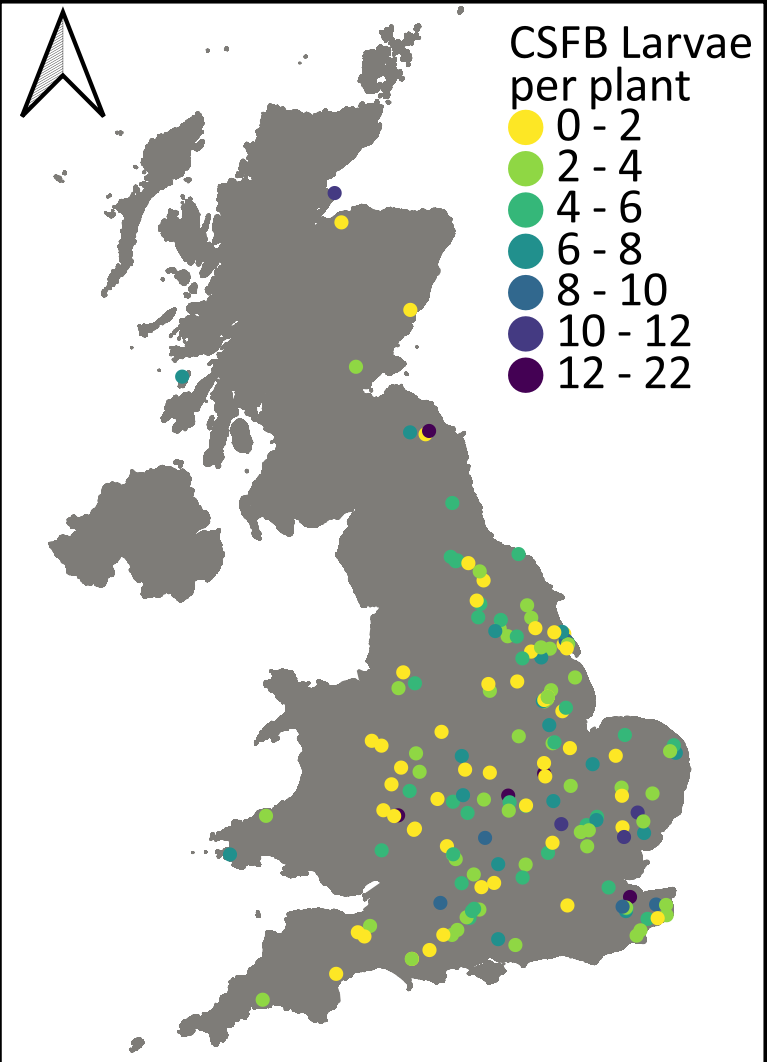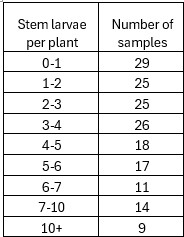Niab Cabbage Stem Flea Beetle (CSFB) Assessment Spring 2025
Sponsored by Hutchinsons, Agrii and United Oilseeds 
Oilseed rape (OSR) remains arguably the most profitable break crop for cereal rotations, and there are plenty of encouraging signs for the season ahead. While the crop has faced challenges in recent years, particularly from cabbage stem flea beetle (CSFB), variable establishment, and pest and disease pressures, the latest data offers renewed optimism for growers considering OSR this autumn.
Understanding CSFB pressure is crucial for planning, and assessing the level of stem larvae in the current crop provides an important early indicator for the season to come.
This spring (2025), Niab conducted a comprehensive assessment of OSR plants from across the UK to evaluate stem larvae levels. This followed on from autumn water trap monitoring, conducted in collaboration with various partners including Niab on behalf of AHDB. Those earlier results had already shown a promising decline in CSFB adult numbers (full data available here).
Purpose of the Spring Stem Larvae Counts
The spring stem larvae counts aimed to:
- Confirm whether lower autumn CSFB adult numbers translated into fewer larvae in stems.
- Explore the value of stem larvae counts as a tool within Integrated Pest Management (IPM) programmes, helping growers with future decision-making.
Growers were asked to send samples of ten plants in mid-February, organised through the project sponsors. Niab processed 174 samples from a strong geographical spread across the country. The larvae were extracted by a dehydration method, encouraging them to leave the stems and allowing accurate counts to be made.
Positive Early Results
Initial findings are very encouraging. Stem larvae numbers are lower than in recent years. Although there are isolated spikes on individual farms, these are not widespread hotspots. Further investigation is ongoing, as these localised higher counts may simply relate to the size of the previous year’s OSR crop in those areas, for example, a smaller 2025 crop following a large 2024 crop could concentrate pressure per plant.
Early postcode heat maps indicate a general, but lower, CSFB presence across most regions, even into Scotland. Figure 1 below summarises the results.
Figure 1: Number of Stem Larvae per Plant

The majority of samples have low larvae counts, giving strong reassurance about CSFB pressure levels for the coming crop.
Context for Growers
AHDB research suggests a potential yield loss of 50–70kg/ha per larvae, depending on plant health. However, OSR crops can comfortably withstand low larvae numbers without significant impact.
Looking back to the last large-scale survey in 2022, not only was the CSFB distribution more uneven, but many hotspots recorded extremely high larvae counts (10–30 larvae per stem). The contrast this year is stark – and encouraging.
What This Means for the 2025 Crop
This year’s data confirms what autumn monitoring suggested: CSFB pressure is significantly reduced. While it’s important to remain mindful of possible reservoirs in brassica-based SFI crops, overall conditions look positive for drilling OSR later this summer.
As expected, slightly higher larvae levels were noted in traditional OSR strongholds like Kent, Norfolk, Cambridgeshire, and Hampshire – but even these are markedly lower than in previous years.
Maximising Success: Agronomy Tips
While the CSFB outlook is positive, success with OSR still depends on attention to detail. Key agronomy advice includes:
- Positioning: Wherever possible, site new crops away from last year’s OSR fields. Most adult beetles emerge from old stubbles.
- Cultivating Post-Harvest: Early stubble cultivation reduces CSFB emergence – ideally immediately after harvest.
- Seedbed Preparation: Moisture conservation is critical. Create a fine, firm seedbed and roll after drilling to secure seed-soil contact and manage slug pressure.
- Flexible Drilling Timing: Adapt quickly to available moisture opportunities, even if it means changing plans at short notice.
- Use of Cover/Companion Crops: Companion crops have consistently proven to support OSR establishment in the past.
Ongoing Work
Niab and the project sponsors (United Oilseeds, Hutchinsons, and Agrii) will continue monitoring the sampled sites into the 2025–26 season. The aim is to provide growers with further valuable insights and to build on the positive momentum currently developing around OSR.
With a careful approach and continued IPM practices, there is real cause for confidence about growing a successful OSR crop in 2025!
